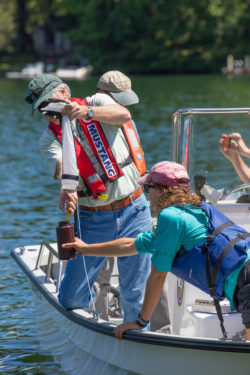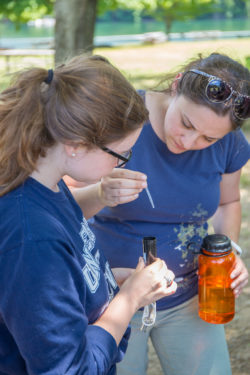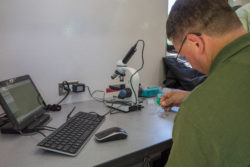Collaborative Citizen Science for Clean Water Management
Posted on Categories Discover Magazine

By Lishka Arata, Conservation Educator at Point Blue
Volunteers collecting a sample from the lake to examine under the microscope. Photo: CMC
Despite the current administration’s efforts to roll back the Clean Water Act and dismantle the Environmental Protection Agency, interest and participation is growing in a new EPA- and stakeholder-led citizen science project that aims to inform clean water management.
The Cyanobacteria Monitoring Collaborative has been gathering steam since 2010, when Hilary Snook, EPA Senior Water Quality Scientist, began receiving calls from state water quality agencies with complaints from their constituents about cyanobacteria blooms occurring in their waters.
A collaborative workgroup was formed between New England state water quality scientists and the EPA in an effort to create something that was stakeholder-inclusive and educational for those concerned about and involved in addressing cyanobacteria blooms and the water quality issues that surround them.
The Collaborative invites anyone interested in or concerned about water quality to collect data that can help predict when and where these cyanobacteria blooms occur. This information enables state and city water resource managers to respond in a timely and appropriate fashion to protect people, wildlife, and domestic animals from harm.
Today, cyanobacteria are having a heyday in many of our waterways, thanks to a combination of extra nutrients that come with runoff from fertilizers on land and rising temperatures from climate change. This is good for cyanobacteria, but not so much for the rest of the ecosystem, including people, in these watery habitats.
The problem is that as cyanobacteria grows, it uses up oxygen in the water and can form thick layers of scum that cover the surface of lakes, ponds, and estuaries. This layer blocks sunlight and consumes oxygen beneficial to other organisms. It can also impair recreational uses of the waterbody such as swimming and boating, and can cause taste and odor issues in source waters used for drinking. Some cyanobacteria species can also release toxins that cause rashes and illness in humans and sickness or death in pets and livestock.

Siphoning off the cyanobacteria which have been allowed to float to the top of a sample separation tool, specifically designed to isolate cyanobacteria from the water sample. Photo: CMC
Toxins produced in waterways by cyanobacterial blooms, sometimes incorrectly called “algal blooms,” are one of the top water quality issues on the planet, according to members of the workgroup. One of the issues surrounding these blooms is the lack of information as to the extent and locations where they are occurring. It is likely that they are often underreported, and more information is needed in order to determine where, and how often cyanobacteria blooms are occurring. That’s where the collaborative comes in.
The project started in Chelmsford, Mass., but is now active nationally and has received several inquiries from outside the U.S. The working group regularly meets in Massachusetts with remote participation from around the country and continued interest from individuals overseas. The program now reaches out to hundreds of people through a list serve and provides trainings and information to groups ranging from middle school classrooms and community groups to climate researchers and state water resource managers.
“The strength of this project is not only in its diverse and collaborative nature, but also in the enthusiasm and energy that contributors bring,” Snook said.
Because the data are collected in the same way everywhere, the information can be used from a local to global scale and across agencies and groups, a powerful and empowering aspect for participants. That means that a middle school student, a stay-at-home dad, and a state water manager can all contribute to addressing a serious issue together that affects us all: maintaining clean water in the face of climate change.
There are three levels at which you can be involved. The first and most basic level is to simply download the bloomWatch app at http://cyanos.org to help track where cyanobacterial blooms happen. This app was launched last fall and the more that people use it, the better it will work to inform appropriate responses to cyanobacterial blooms in our waterways. The app is easy to use and contains educational information about the issue as well.

Preparing a slide for the microscope with the attached tablet computer for directly uploading images to iNaturalist.org. Photo: CMC
The second level of participation involves getting a little more sciencey and joining Cyanoscope to understand and map which types of cyanobacteria occur where, when. Don’t be scared by the science though, this level works equally well from the middle school level and to professional researchers.
The third level, cyanomonitoring, involves investigating what environmental factors influence blooms throughout the year and over time.
Just go to http://cyanos.org to learn more about how to get involved with the Cyanobacteria Monitoring Collaborative. When you’re there you can download their app and get information on how to join the effort at one or all of the three levels.
As Snook says, “The project doesn’t point the finger or claim to solve the problem, but it welcomes anyone to be involved in creating a powerful educational and decision support tool. You might even have some fun along the way.”
Want more citizen science? Check out SciStarter’s Project Finder! With 1100+ citizen science projects spanning every field of research, task and age group, there’s something for everyone! Interested in receiving updates on citizen science projects and events through our newsletter? We would love to get your feedback.